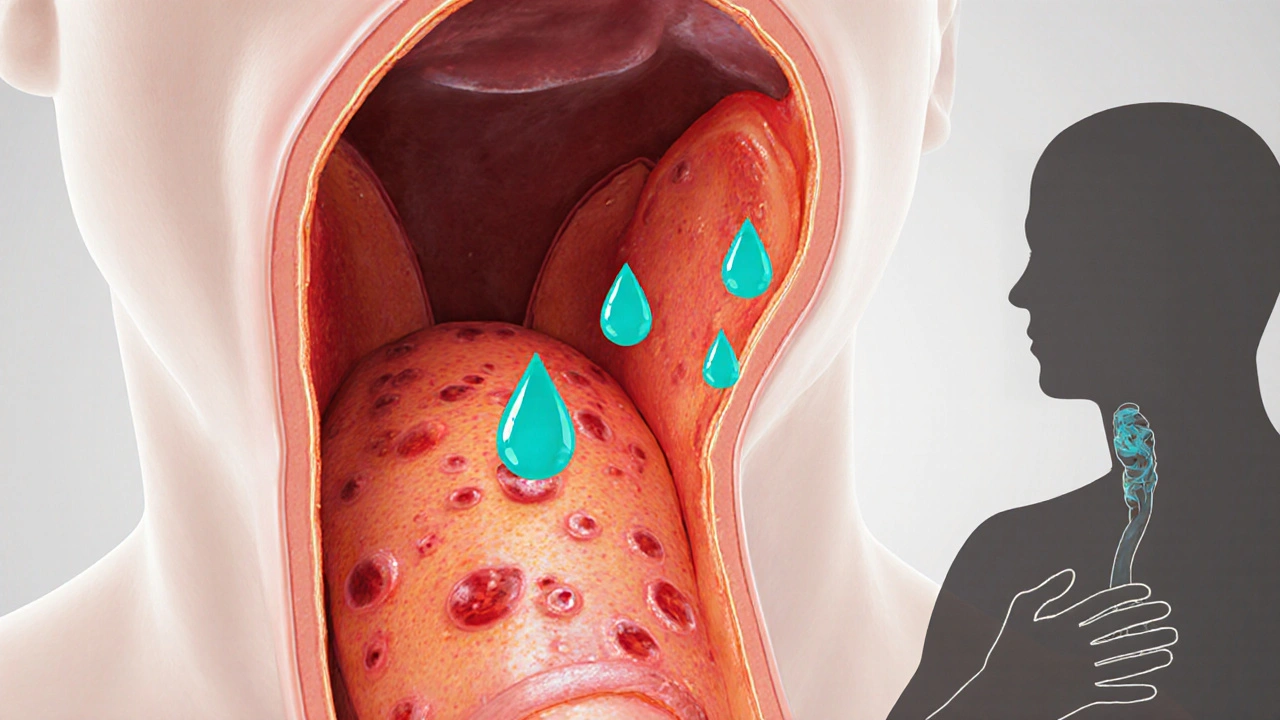Exercise Timing & Reflux Risk Calculator
Personalized Exercise Risk Assessment
Based on medical guidance for erosive esophagitis, determine your risk level for reflux during exercise.
Symptom Log
Track your exercise symptoms to identify patterns.
Recent Log Entries
Living with erosive esophagitis can feel like a constant battle between meals and discomfort. You’ve probably heard that diet, medication and weight loss matter, but what about moving your body? Below we break down how different kinds of physical activity interact with the esophagus, which workouts are safest, and how to build a routine that eases, rather than aggravates, your symptoms.
What Is Erosive Esophagitis?
Erosive Esophagitis is an inflammation of the esophageal lining that results in tiny breaks or ulcers caused by stomach acid repeatedly spilling upward. The condition is a severe form of gastro‑oesophageal reflux disease (GERD) and often shows up as heartburn, chest pain, difficulty swallowing, or a sour taste in the mouth.
When the protective mucus layer is worn away, the exposed tissue can bleed, scar, and become hypersensitive. Over time, untreated erosive esophagitis can lead to strictures or Barrett’s esophagus, a precancerous change.
Why Exercise Might Influence Symptoms
Exercise doesn’t act directly on the stomach, but it changes several risk factors that drive acid exposure:
- Body Weight: Excess abdominal fat increases intra‑abdominal pressure, pushing gastric contents upward.
- Lower Esophageal Sphincter (LES) Function: Certain movements can temporarily relax the LES, allowing reflux.
- Hormonal balance: Physical activity improves insulin sensitivity and lowers cortisol, both of which can reduce reflux episodes.
- Digestive motility: Moderate aerobic work speeds up gastric emptying, leaving less acid to back‑flow.
In short, the right kind of workout can lower the pressure that forces acid up, while the wrong kind can exacerbate it.

Exercise Types and Their Impact
Below is a quick comparison of the most common exercise categories and what the research says about their effect on reflux and erosive esophagitis.
| Exercise Type | Typical Effect on LES Pressure | Reflux Risk During Activity | Best Timing Relative to Meals |
|---|---|---|---|
| Low‑impact aerobic (walking, cycling, swimming) | Neutral or slight increase | Low | 30‑60min after a light meal |
| High‑intensity interval training (HIIT) | May transiently lower LES tone | Moderate‑high, especially if core is heavily engaged | Wait 2‑3hours after eating |
| Strength training (weightlifting, body‑weight circuits) | Can lower LES during Valsalva‑type lifts | Moderate; risk spikes during heavy squats or deadlifts | Prefer sessions on empty stomach or after a very light snack |
| Yoga & Pilates (focus on gentle flow) | Generally neutral, but extreme backbends can compress abdomen | Low‑moderate | 30min after meals; avoid deep inversions after large meals |
Practical Exercise Guidelines for Symptom Management
- Start with low‑impact aerobic activity. Aim for 150 minutes a week of brisk walking, steady‑state cycling, or swimming. These motions keep the LES closed while promoting gastric emptying.
- Mind the timing. Finish eating at least two hours before a workout. If you need a pre‑session snack, keep it under 150kcal and low in fat (e.g., a banana or a small yogurt).
- Stay upright. During and after exercise, avoid lying down for at least 30 minutes. Gravity helps keep acid where it belongs.
- Watch core pressure. When you lift weights, exhale on the exertion phase instead of holding your breath (the Valsalva maneuver). This reduces intra‑abdominal pressure that can push acid upward.
- Hydrate wisely. Sip water throughout the session but avoid large gulps that distend the stomach.
- Include flexibility work. Gentle yoga or stretching after cardio can improve posture, reducing the chance of hiatal hernia‑related reflux.
- Track symptoms. Keep a simple log: note the type of activity, duration, and any heartburn or chest discomfort that follows. Patterns will reveal which workouts you tolerate best.
When Exercise Might Worsen Symptoms
Not every movement is friendly to an inflamed esophagus. Here are red flags that signal you should pause or modify the routine:
- Intense abdominal crunches or leg‑raises that make you feel a “burn” in your chest.
- Heavy deadlifts or squats performed with a tight, held breath.
- Late‑night cardio sessions right after dinner.
- Any activity that forces you into deep inversions (head‑stand, shoulder‑stand) within an hour of eating.
- Sudden spikes in heart rate that leave you gasping and lead to post‑exercise heartburn.
If you notice any of these, switch to a gentler alternative for that day and reassess after a week.

Combining Exercise with Medical Treatment
Exercise alone rarely cures erosive esophagitis, but it can boost the effectiveness of standard therapies. Most patients are prescribed Proton Pump Inhibitors (PPIs) to lower acid production. Regular physical activity helps maintain a healthy weight, which in turn reduces the dosage needed for long‑term acid control.
Discuss your workout plan with your gastroenterologist, especially if you’re starting a new regimen while on PPIs or other reflux medications. Some drugs may cause mild nausea after vigorous activity; timing doses around exercise can minimize discomfort.
Key Takeaways
- Low‑impact aerobic exercise is the safest bet for most people with erosive esophagitis.
- Avoid heavy core‑centric lifts that force you to hold your breath.
- Schedule workouts at least two hours after meals and stay upright afterward.
- Weight management through regular activity can lower the reliance on high‑dose PPIs.
- Keep a symptom log to fine‑tune the type and timing of exercise that works best for you.
Frequently Asked Questions
Can walking really reduce reflux episodes?
Yes. Walking at a moderate pace promotes gastric emptying and keeps intra‑abdominal pressure low, both of which lower the chance of stomach acid traveling back into the esophagus.
Is it safe to do high‑intensity interval training (HIIT) if I have erosive esophagitis?
HIIT can be safe, but you should give yourself a longer gap after meals (at least three hours) and avoid exercises that involve deep crouching or forced breath‑holding. Start with shorter intervals and monitor how your chest feels.
Do strength‑training workouts increase the risk of esophageal ulcers?
They don’t cause ulcers directly, but heavy lifting that squeezes the abdomen can temporarily lower LES pressure, leading to more reflux. Use proper breathing techniques and keep weights moderate until you know how your body reacts.
Should I stop exercising if I’m on proton pump inhibitors?
No need to stop. In fact, exercise can complement PPIs by reducing weight‑related pressure. Just watch for any medication‑related side effects like dizziness during intense cardio and adjust the intensity accordingly.
What’s the best time of day to work out with erosive esophagitis?
Morning workouts after an early, light breakfast are ideal for most people because the stomach is usually empty by the time you start moving. If you’re a night owl, ensure you finish dinner at least two to three hours before your session.


13 Comments
The physiological interplay between intra‑abdominal pressure and LES tone suggests that moderate aerobic activity can act as a protective adjunct for erosive esophagitis. By enhancing gastric emptying, walking or cycling after a light meal reduces the volume of acid available for reflux. Moreover, regular exercise contributes to weight reduction, thereby lowering chronic pressure on the gastro‑oesophageal junction. I would therefore recommend scheduling low‑impact sessions at least two hours post‑prandial to maximise benefit. Consistency, rather than intensity, remains the paramount principle for long‑term symptom control.
That aligns well with the notion that gradual exposure, rather than abrupt spikes in exertion, supports a more stable LES environment. A gentle walk after dinner, coupled with mindful breathing, often yields noticeable relief for many patients.
I hear how frustrating those nightly heartburn episodes can be, especially when you’re trying to stay active. It helps to choose workouts that keep the torso upright and avoid breath‑holding during lifts. A short, brisk walk after a modest snack can be surprisingly effective at moving food along. Remember to stay hydrated in small sips and give yourself at least thirty minutes before lying down. Consistent logging of what you feel after each session will eventually reveal your personal sweet spot.
Think of the LES as a gatekeeper; low‑impact cardio keeps it politely closed, while heavy deadlifts yank it open. A quick bike ride after breakfast often feels like a gentle nudge toward better digestion. Skip the deep backbends right after a big lunch, and you’ll thank your throat later.
Sure, because nothing says ‘relief’ like a HIIT sprint right after a cheeseburger.
When you look at the body of research linking physical activity to gastro‑oesophageal reflux, the consistent thread is that moderate, steady‑state aerobic exercise tends to improve symptom scores.
A 2017 randomized trial compared walking at 3‑4 mph to a control group and found a 30 percent reduction in nightly heartburn frequency after eight weeks.
The mechanism appears to be twofold: enhanced gastric emptying and a modest reduction in intra‑abdominal pressure due to improved body composition.
In contrast, high‑intensity interval training can generate rapid spikes in intra‑abdominal pressure, particularly when the Valsalva maneuver is employed during sprints.
Those pressure peaks may temporarily overcome the LES, allowing acid to reflux into the esophagus.
That said, not all HIIT is created equal; intervals that focus on lower‑body movements without excessive core loading pose less of a risk.
If you’re inclined toward HIIT, I suggest a 20‑minute session consisting of light bike intervals, keeping the resistance moderate and avoiding deep squats.
Timing remains critical – aim for at least three hours after a substantial meal before you start, and consider a brief warm‑up walk to prime the digestive tract.
Strength training presents a similar paradox: the act of lifting heavy weights can induce a Valsalva breath hold, which spikes abdominal pressure.
A practical compromise is to employ a breathing strategy where you exhale during the concentric phase and inhale during the eccentric phase.
Additionally, limiting the load to a range where you can maintain proper form without clenching the core excessively will keep LES pressure more stable.
Flexibility work, such as gentle yoga, can be a valuable adjunct because it promotes good posture, which in turn reduces hiatal hernia strain.
Just avoid deep inversions like head‑stands or shoulder‑stands within an hour of eating; those positions reverse gravity and can easily provoke reflux.
Hydration strategy also matters – sipping water throughout the session helps but large gulps can distend the stomach and undo your efforts.
From a patient‑centered perspective, keeping a simple log of activity type, timing relative to meals, and any subsequent symptoms is perhaps the most powerful tool you have.
Over weeks, patterns will emerge, allowing you to fine‑tune a routine that both supports your overall health and keeps that burning sensation at bay.
One might argue that neglecting the body’s natural signals in pursuit of a sculpted physique borders on ethical irresponsibility; the esophagus is not a battleground for vanity.
Wow!!! You’ve nailed the idea that a simple walk can be a game‑changer for reflux!!! Keep those gentle sessions after meals and watch the burning melt away!!! Stay upright, stay hydrated, stay happy!!!
From a holistic standpoint, the integration of low‑impact aerobic activity within a post‑prandial window aligns with the principle of temporal harmony in bodily processes 😊. It is advisable to observe a minimum interval of thirty minutes to an hour before commencing movement, thereby allowing gastric emptying to progress. Such practice not only mitigates reflux risk but also reinforces cardiovascular health, which is essential for overall well‑being. Should you encounter persistent discomfort, a consultation with a gastroenterology specialist is prudent 🌟.
I have read several studies on exercise and reflux and the consensus seems clear low impact cardio helps the LES function while intense core work can increase pressure My own experience mirrors that I started walking after dinner and the night-time heartburn decreased significantly Over time I added light cycling and kept strength sessions brief and breath‑controlled The key is consistency not intensity and a simple symptom log can provide data to refine the routine
Honestly the article gets most of the basics right but it completely ignores the role of hiatal hernia which is a major contributor to reflux especially in active individuals. Also, the suggestion to 'stay upright' is vague – you should actually avoid any forward flexion for at least 30 minutes after a workout. Lastly, the claim that yoga is low‑risk ignores deep inversions that can actually worsen symptoms. If you want real guidance you need to read up on the latest guidelines.
Kickstart your day with a brisk 20‑minute walk after a light breakfast, and you’ll notice the esophagus staying calm. Mix in some body‑weight circuits but remember to breathe out on the lift – that simple tweak saves you from a late‑night burn. Keep a quick note on your phone after each workout; patterns pop up faster than you think!
One must consider that the mainstream fitness industry subtly promotes high‑intensity regimens without disclosing their latent impact on gastro‑oesophageal integrity, a fact conveniently omitted from commercial brochures. The suppression of this information serves corporate interests seeking maximal consumer expenditure on pharmaceutical reflux remedies. Therefore, a prudent individual should scrutinize every recommendation and favor low‑impact modalities that align with the body’s natural physiology.